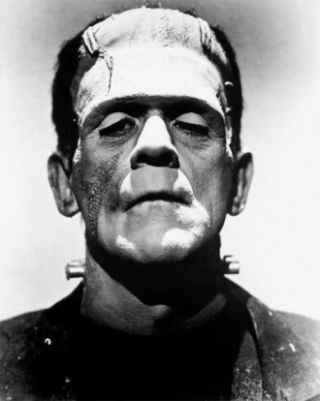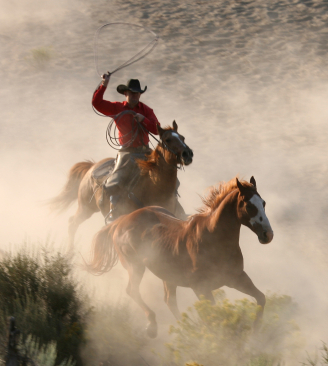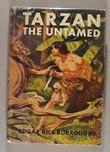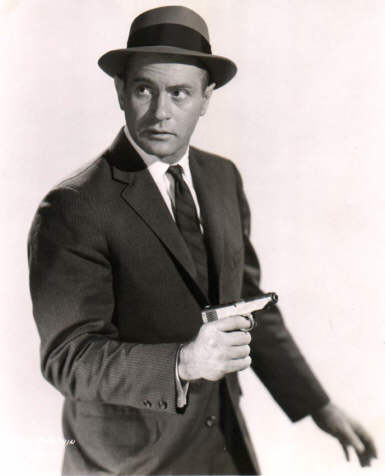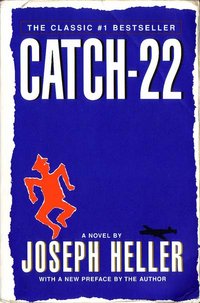|
Literature 110 - Popular Literature Spring 2013 - Ticket #62740 // Marjorie Coverley Luesebrink, MFA, Instructor |
|
Unit 1: Introduction: What is Popular Literature?
POPULAR FICTION IN OUR LIVES Most of us have spent at least one delightful and lazy day reading at the beach or at the park, in a hammock at home or at a mountain camp site. Usually, the books we choose for such a delicious interlude are ones that have a vivid and exciting plot, lots of sensory imagery, and one or two engaging characters. We refer to these books casually as Beach Reading or Escape Reading - and sometimes we even say "junk" reading. But book lovers of all stripes (from those who love the literary to those who never venture beyond the dime novel) will often have favorites among the more "popular" books. Sometimes, even, very difficult and sophisticated literary books are found in Beach Bags and on Lounge Chairs!
Movie Version of Dr. Frankenstein's Monster I point this out to show, first, the difficulty of narrowing down the concept of "Popular Fiction." Jane Austen was, and continues to be a widely-read author. *Pride and Prejudice* has been read by many, many people. Despite its universal appeal, this book is considered "literary" and is not counted as a piece of "Popular Fiction." Contrast that with Mary Shelley's Monster. One of the most "popular" books of all time in terms of overall readership, movie adaptation, and general icon recognition is Mary Shelley's *Frankenstein.* It is considered "Popular Fiction." And yet, Shelley was a serious writer, and this story is an acknowledged literary masterpiece in many ways. (We will be reading this great book in our class!) On the other hand, Marie Belloc Lowndes' *The Lodger* (another text we will be reading) was a raving success in late Victorian times but is less well known today - even though the subject matter, Jack the Ripper, continues to inspire retellings!
Jack the Ripper in the London Fog I use these three examples to illustrate that "popular" fiction does not necessarily mean "junk" fiction or badly written prose! On the contrary! Much of the literature that we have loved over the years is truly fine fiction and contains excellent writing. Of course, there are thousands of pieces of fiction that were once popular that don't hold up so well - and may have been rather indifferently written, as well. The sheer volume of the fiction that has been published in the last 200 years leads us, sometimes, to assume that if a work was enormously popular, it had to necessarily be inferior, too. In this class, I will argue that key pieces of "popular" fiction are still both fun to read and important to literary study! So how, then, you might ask, DO we distinguish between real "literary" fiction and "popular" fiction, if some of the popular ones are also important literature? We can't, really; to a large extent there are overlaps and special cases and so forth in these classifications. But in general terms, we can always include in Popular Fiction works that can be categorized as "Genre" works. [You will note that our study curriculum is organized by genre.] If a novel fits the criteria of Horror, Crime, Detective, Romance, Western, Science Fiction, or Fantasy, then we usually can include it in Popular Fiction (even if it also has all the traits of Literary Fiction). Beyond the large-scale genres that we easily recognize, publishers also define genre books by very specific sub-genres. British novels, for instance, in which we never see the murder are called "Tea Cozy Crime Novels" (:-))
Cowboy Fiction was once very popular
I am going to utilize the definition of Genre fictionFrom Wikipedia, the free encyclopedia (you can read more, here -http://en.wikipedia.org/wiki/Genre_fiction)to illustrate one way of looking at Popular Fiction: Genre fiction is a term for fictional works (novels, short stories) written with the intent of fitting into a specific literary genre in order to appeal to readers and fans already familiar with that genre. In contemporary fiction publishing, genre is an elastic term used to group works sharing similarities of character, theme, and setting—such as mystery, romance, or horror—that have been proven to appeal to particular groups of readers. Genres continuously evolve, divide, and combine as readers' tastes change and writers search for fresh ways to tell stories. Classic romance novels, such as those written by Jane Austen in the nineteenth century, continue to enjoy popularity today in the form of both books and movies. Despite its popularity, genre fiction is often overlooked by institutions - the reviewing pages of the mainstream newspapers, for example - that favor literary fiction. The reviewing venues for genre fiction are primarily niche media: prozines (professional or industry fanzines), fanzines, and so on. All fiction is essentially generic. But genre fiction is overtly and intentionally so, signalling its generic identity in the clearest possible terms. A horror novel, for example, makes it clear through its cover design, its blurb, the comments printed on the cover from other novelists, and so on, that it is a horror novel; and it will be shelved in the appropriate place in bookstores. Genre fiction is often used interchangeably with the term popular fiction, and generally distinguished from literary fiction. A comprehensive discussion of these issues is found in Ken Gelder, Popular Fiction: The Logics and Practices of a Literary Field (2004). An excellent earlier discussion is John Sutherland, Bestsellers: Popular Fiction of the 1970s (1981).
Much of popular fiction depends on a literatry Trope - a word we will use often - please look at the website with all the definitions so you have a broad idea of how these Tropes can work.
WHEN DOES POPULAR FICTION BEGIN?
The formal, publishing category of "Popular Fiction" begins in the 19th Century - a time when wider literacy and cheaper printing make books available to middle-and-lower-class readers. But, if we just look at the phenomena of popular stories, genre literature goes back to the earliest folk tales and continues in privately-circulated manuscripts throughout history. We think of "Tarzan" as being a creature of the 20th Century - a "popular" hero. Still and all, the concept of the "wild man of the forest" shows up in tales from our earliest beginnings. Enkidu, the friend of Gilgamesh (in the epic tale of Gilgamesh), was a rough and wild outsider, raised in the forest. The oldest surviving manuscripts that tell this story are from a couple of eons ago, but we know they came originally from ancient Sumerian times - 3000 BC or thereabouts! (This epic also includes an account of "The Flood" - another popular tale!) So we do know that stories which engage the attention of many people over time have always existed and continue to inspire popular literature. We have always been fascinated with Romances, with Adventures, with Ghosts and Monsters and Crimes. However, once the "book" became a part of entertainment options for the masses, though, we had a flowering of new stories and themes. Some of these themes (the Science Fiction aspects of *Frankenstein*, for example) would not have been possible in the world before 1800. The same is true of the Cowboy/Western genre. It was the rather new and unexplored territory of American expansion that gave rise to the legends and novels about cowpunchers. And, after 1900, when American Literature came to be appreciated and American writers challenged the dominance of British writers in English, the categories, and the differences between "literature" and "dime fiction" became muddier. Also, after 1900, a wider readership and better distribution of books encouraged the recognition of even more new movements, genres, and writers.
By the 20th Century, Popular Fiction was published in inexpensive magazines available to all [Remember, if there are terms mentioned in the lecture that you would like to be more familiar with, you can always "Google" them. Just go to Google and type in any term that puzzles you! The first entries on the Google list are usually quite generic and will give you a fine idea of what "Victorian Literature," for example, is all about!] THE VITALITY OF POPULAR LITERATURE While "Popular Literature" was published and widely read in the 19th Century, by the 20th Century it had become a world unto itself. During the 20th Century, the growth of readership and genres in "Popular Literature" made "Literary" Literature seems like a small and exclusive "academic and scholarly" market. The ratio of sales told it all: Popular Literature comprised almost 90 % of the market for fiction. "Literary" fiction was relegated to about 5% of the sales (but not the titles!). When we think about literature at all, we tend to think of the famous authors who were "literary" writers such as Hemingway and Faulkner - but average folks across the globe were buying and reading fiction in great numbers - and they didn't stick to the "classic" names. Moreover, many "popular" writers became just as well known as the literary authors! We will be reading many of the authors who became household favorites in the 19th and 20th Centuries - including Mary Shelley, Zane Grey, and Margaret Mitchell. Also, in our lectures, we will study other writers who have made an impact on our culture and our imaginations over the years.
THEMES OF THE
CENTURIES
Although "popular" fiction is primarily "genre" fiction, and, as such, restricts its themes to the requirements of the genre, several important themes have surfaced in mainstream fiction over the last two decades. In a sense, popular fiction tends to be more closely tied in to contemporary or current concerns and trends than does "literary" fiction. It tracks closely with the mood and the tempo of its time. When we read Mary Shelley's Frankenstein, we are amazed at how modern this book seems - and yet, it was first popular at a time when the whole idea of emerging scientific phenomena was wildly fascinating to readers in 1818 - almost two hundred years ago! On the other hand, when we read Zane Grey's Riders of the Purple Sage, we immediately sense that the Cowboy West of which he writes is long gone for us. Still and all, for his readers at the time, the loss of the frontier created an immediate sense of loss and nostalgia, and folks were longing to read about times when wide-open-spaces were filled with brave men and lots of cows (ha!). Popular writers also investigated themes that might have been unsuitable in "literary" literature. Raymond Chandler's detective, Philip Marlowe, was exactly the kind of guy who would be persona non grata (not welcome) as the protagonist of a proper novel. He's a sleazy fellow, a kind of L.A. type who wears seersucker suits and peacock-blue socks. He knows the low-lifes. And he is not a heroic type in any sense. Still and all, he tickled the fancy of a readership who could identify with him - might have even known somebody like him.
Phillip Marlowe, Raymond Chandler's sleuth In both Europe and America, the theme of "crime" has been important to people - and the popular fiction of each era focused on the kinds of specific crimes and situations that were important in that day. Marie Belloc Lowndes' The Lodger drew its audience from a population that was transfixed by "Jack the Ripper." Raymond Chandler's criminals are slightly more tidy, but inhabit a world that is, by the mid-20th Century, much more complicated and interconnected.
ANOTHER WAR? Before anyone could say “make the world safe for Democracy” the world was at war during long periods of the 20th Century. WWI and WWII both gave rise to exceptional fiction - and very popular fiction at that. It would seem, though, that the mainstream fiction about the World Wars came to rest in works that we generally consider "literary" today. Erich Maria Remarque's All Quiet on the Western Front has continued to enjoy widespread acclaim - and Joseph Heller's Catch 22 was not only a popular novel, it gave rise to "M.A.S.H." - a long-running and influential TV show. But war is always a timely theme - even wars of the past. The American Civil War has continued to spark novels both popular and literary up until today. Mitchell's Gone With the Wind has the Civil War as its central theme - but I would also argue for the thematic importance of what we could call "American Romance." [more about this when we are reading that novel!] Original cover for Catch 22. Also! Site about the Movie.
WHAT'S AHEAD Along the way, as we explore the genres of Popular Literature, I will be making a lot of suggestions of things you might want to read later on. Also, there are links to other resources on the Web included throughout the lectures. If you aren’t already familiar with a writer or a work, I suggest that you follow those links and learn about the material. The lectures are very condensed – and they require not only slow reading but taking the time to explore the links off-site and fill yourself in on unfamiliar background information. Of course, the Discussion List is for questions
and further exploration – so I look forward to talking to you about
the whats and whys of Popular Literature! The title of this Lecture – What is Popular Literature – should be more clear to you now. However, no one definition or set of criteria can really encompass something as big and as particular as Popular Literature. No two people would even, probably, agree on a comprehensive list! Our challenge is to learn more about the topic by reading the books and exploring the period and culture that produced each one! Then, we are fortunate enough to enjoy a great environment to discuss what we have found and share our ideas with others who have read the same material! It is magic, somehow. See you on the Discussion Boards.
Note here: if you really haven't read very many books at all, I have provided some links here for all of you to explore some famous popular writers and some works that we are not reading!!
Links: Horror: Mary Shelley is surely the pre-eminent inventor of the horror genre, but Popular Literature is notable for the excellence of the writers in this genre: Bram Stoker, author of Dracula: This site has a discussion of the horror story, biographical information on Bram Stoker, forum for scholars and students, and the complete text of Dracula for you to read! http://www.online-literature.com/stoker/dracula/ Stephen King - a very popular author that many of you may have read - his official website: http://www.stephenking.com/ Western: While the "western" writer we might be most familiar with is Zane Grey, another wildly popular writer of "western" genre books (who we will be reading) was Louis L'Amour. Here is his bio page: http://www.louislamour.com/aboutlouis/biography.htm. The page includes links to lists of titles. War: Margaret Mitchell: forever associated with Gone with the Wind. Joseph Heller Biography: http://www.kirjasto.sci.fi/heller.htm Joseph Heller and Catch 22: http://www.webster.edu/~barrettb/heller.htm In Flanders Field: http://www.greatwar.co.uk/poems/john-mccrae-in-flanders-fields.htm
Romance: A very interesting site about contemporary romance fiction (note especially the sub-genres of this for publishing purposes): http://www.writing-world.com/romance/romgenres.shtml Popular romance writers are legion, so I chose only one site of a popular romance fiction author - but all you need to do to find out more about your favorite is to enter the name into Google Search. But maybe some of you have read: Nora Roberts - http://www.noraroberts.com/ Surprisingly enough, one of the best selling romance writers of today is actually a man, Nicholas Sparks, and we see his books on shelves and towels everywhere: http://www.nicholassparks.com/TheNovels.html Detective Fiction (one subcategory of Crime Fiction): The detective genre continues to be very popular all over reading-land - and fans seem to be particularly widely read in the field! Some good historical/traditional authors include: Arthur Conan Doyle: http://www.sherlockholmesonline.org/ - Sherlock Holmes is the epitome of the classic detective. Even if you have not read Doyle's books, you probably know a lot about Sherlock! P.D. James: A woman writer, with an amazing knowledge of police procedure, is a perennial favorite. Agatha Christie: A taste for Agatha can be satisfied almost any time - she has written a LOT of books! Raymond Chandler: Raymond Chandler - an author we will be reading, was one of the first "gumshoe" detective genre writers. His books recall a classic period of Los Angeles history. Dashiell Hammett: Another popular traditional California author - his fiction is both "hard-boiled" and "gumshoe."
Crime: while "detective" fiction keeps its discovery process right in the Point of View of the Detective, Crime Fiction, an umbrella category for all fiction that involves crime, often tells the story from a different point of view with perhaps an unusual kind of narrator (innocent bystander, curious reporter, would-be-victim). Some of our detective writers (such as P.D. James) also write other kinds of Crime Fiction. But the genre has a wide variety of approaches. Marie Belloc Lowndes, of course, is one writer we will become familiar with as we follow her treatment of Jack the Ripper - her fiction could be included in a sub-category of "psychological thriller," as well. but you also might like to sample: Edgar Allen Poe: Poe's classic tales of live incarceration and mystery are full of criminal (and psychological) detail! A list of the 100 best mystery writers will give you an idea of the roll call of these writers! From The Mystery Writers of America.
Fantasy: Harry Potter and the Sorcerer's Stone: be sure to see J.K. Rowling's Official Website. A favorite among fantasy fiction readers for years has been The Lord of the Rings - and the entire series by J.R.R. Tolkien. (Note, here, the similarity of naming of "JRR" and "JK" - just another of Rowling's "slant reverences"!) C.S. Lewis blends fantasy and his own brand of Spiritual Humanism - many people are familiar with his Narnia series which has created a whole classic strain in fantasy literature. I do realize that there are many other sub-genres in fantasy fiction - and I will leave it to the students who have particular expertise in this area to help me fill it in! To see the amount of overlap in our "categories", we can take a good look at the 100 best Fantasy Fiction Books published by Fantasy 100: <http://fantasy100.sffjazz.com/>. On this list you will find not only Tolkien and Lewis, but others that we have in different categories such as Stephen King, Anne Rice (Interview with a Vampire), Bram Stoker (Dracula) [all in our Horror category], and Ursula K. LeGuin and Ray Bradbury (who we will find in our Science Fiction Category but also write Fantasy Fistion. There are some amazin authors here! Take a good look for your Research Paper! Science Fiction: Ursula K. Le Guin has a fantastic Web Site! Ray Bradbury is a long-time favorite. Although best known for The Martian Chronicles, Bradbury has been writing wonderful books for decades! Actually, should we want to talk about Categories overlapping, we have the perfect example with Science Fiction - one of the reasons for this is that much "real literature" is science fiction in content - and many of the fantasy and mystery genre tropes can also be seen as SciFi. Take a look at this list from Wikipedia of top SciFi Authors: this list is a treasure in itself! If you are having trouble finding an author for the Research Paper, it is a good place to start looking! A note about Wikipedia: You will see that I freely use Wikipedia sites for our links. I do this because they are very useful for a 'first pass' introduction to a subject. However, I do want you to know that you should never depend on Wikipedia alone for a reference for a paper or project. I recommend that you start with Wikipedia to get an overview on an item - then use all of your other resources, both print and electronic, to be sure you have a fully expanded and filled out picture of your subject. You can use Wikipedia in your Bibliography, but then I would expect to see the followup material, as well!
MENUBAR: About Your Class // Class Syllabus // Lecture Notes // Reading List // Recommended Reading // Assignments // Grading Policies // Contact Your Instructor // Announcements // Discussion
Marjorie Coverley Luesebrink, MFA, your Instructor, is a Professor of English in the School of Humanities and Languages Irvine Valley College, Irvine, California
|
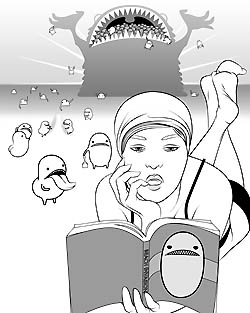 Irvine Valley
College
- Online Literature Study of the School
of Humanities and Languages
Irvine Valley
College
- Online Literature Study of the School
of Humanities and Languages
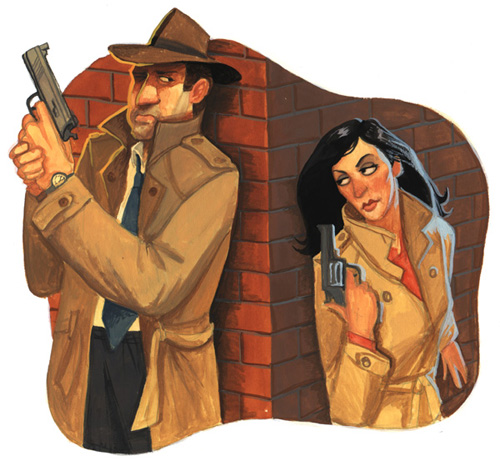 Detectives! (Extra fun - the history of
Detectives! (Extra fun - the history of 